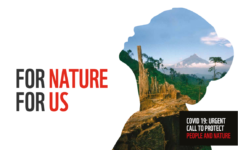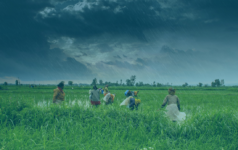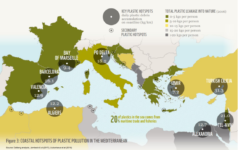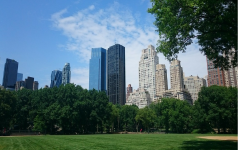Dalberg uses cookies and related technologies to improve the way the site functions. A cookie is a text file that is stored on your device. We use these text files for functionality such as to analyze our traffic or to personalize content. You can easily control how we use cookies on your device by adjusting the settings below, and you may also change those settings at any time by visiting our privacy policy page.
The last few months have seen a new wave of public outrage over marine plastic pollution. Shocking statistics are capturing the headlines, including the fact that by 2050 the ocean will hold more plastic than fish by weight, and that 4.8-12M tons of plastic waste is dumped in the ocean daily of which 95% will be impossible to recover. We are all increasingly familiar with images of floating garbage patches as large as countries, of suffering wildlife entangled in plastic waste. A sperm whale, one of the world’s largest mammals, recently died due to the 64 lbs of plastic in its stomach.
While this renewed public engagement in plastic pollution is encouraging, tackling the issue still presents some critical challenges.
- Plastic pollution is a huge issue for the ocean, but it’s also a threat to land and people:
Beyond the headlines, plastic pollution is more than a marine issue: it is a climate, health, social and economic problem. Communicating this effectively is an essential step towards driving action against it. Plastic pollutes nature at each stage of its life-cycle, from the extraction of fossil fuels for virgin-plastic production, to the release of greenhouse gases during manufacturing and incineration, and the leakage of toxins into the earth from unsanitary landfills. There are growing concerns regarding the effect of plastic on human health, as we ingest plastic daily through contaminated seafood and drinking water and are exposed to the release of chemical additives. Finally, economic implications are emerging as unsightly waste and clean-up costs are affecting tourism, fishing and shipping sectors.
Air pollution: Plastics is one of the fastest growing uses of fossil fuels, currently making up 8% of the global yearly petrol use, more than the aviation industry. Greenhouse gasses are emitted during production and incineration, and by 2050 plastic will be responsible for 15% of the world’s carbon budget.
Land pollution: In the top 20 waste-producing countries, on average 68% of waste is mismanaged, ending up in nature or unsanitary dumps. Plastics which do end up in landfills can leach harmful chemicals into the environment.
Endangering wildlife: 90% of all encounters between wildlife and marine debris are caused by plastic, often through entanglement and ingestion. 700 species have been affected.
Health: 93% of major bottled water brands tested by Orb Media showed signs of micro-plastic contamination, which is now being investigated for health concerns.
Economic impact: In the APAC region, the tourism industry loses an estimated USD 622 million per year due unsightly waste and clean-up costs, and fishing and shipping industries lose up to USD 279 million, as plastic waste gets caught in equipment and affects the fishing ecosystem.
Despite the far-reaching nature of the plastics issue, current initiatives are still concentrated on decreasing the flow of plastic into the ocean, rather than on tackling the issue at its source. Civil society, policy makers and investors alike are focusing on downstream activities: improving the waste management capacity of ‘top polluting’ countries in the Asia-Pacific region who are responsible for 60% of plastic leakage into the ocean, advocating for extended producer responsibility from large companies, organizing ocean clean-up operations, and more. However important these initiatives are, decreasing the mis-management of waste is an insufficient measure against the ever-growing flow of plastic. Upstream solutions to curb virgin plastic production, re-design and minimize plastic consumption and close the loop through recycling are equally important pieces of the puzzle. While exciting innovation is emerging around sustainable inputs and re-design plastic packaging, these innovations haven’t been adopted at a meaningful scale.
- We need effective incentives to transform the way we produce, use and dispose of plastic in order to develop new scalable solutions.
The pervasiveness of plastic across all aspects of modern society has led some to believe these decades will be dubbed ‘the Plastic Era’. The world is currently producing 335 million tons of plastic per year, and the total amount of plastic waste is expected quadruplebetween 2010 and 2050, driven by the low prices of oil and the declining demand for oil as fuel. This has led to a linear flow of plastic, which is primarily designed for single-use by industry and consumers, and then deposited into a waste management system that has not evolved alongside the growth in production. In fact, even according to highest growth estimates, global recycling capacity is only expected to cover 1/3 of all waste produced by 2050, leaving the rest to landfill, incineration, or leakage into nature. A systems-transformation will be necessary to address plastic pollution at each stage of this linear value chain.
In line with this thinking, we are increasingly seeing organizations like the Ellen MacArthur Foundation and the World Economic Forum advocate for a “New Plastics Economy”, which seeks to replace the current linear value chain with a circular model. This model requires a shift from fossil-fuels to sustainable inputs, innovation to reduce and improve plastic consumption, and the development end-of-life solutions.
However, the business case for a more sustainable plastics economy is still missing. While some consumer goods companies are leading the way by committing to reach 100% re-used, recycled or degradable packaging by 2025 or to recollect the equivalent of all plastic sold by 2030, the majority of companies are yet to commit to significant targets. The quality and availability of bio-plastic or secondary plastic remains far lower than that of virgin plastic, which is also still cheaper to obtain. Consumer pressure for sustainable packaging is not yet strong enough to sway companies toward rolling-out innovation at scale, and in absence of policy, industry self-regulation is not going far enough.
Creating positive incentives to drive a meaningful shift towards the circular economy will require large public and policy pressure. Policy-makers need to incentivize businesses to commit and deliver on impactful targets, while the public can drive change with consumer preferences and behaviour change. Herein lies the key challenge of the plastic pollution issue: it will require coordinated action across the whole plastic value chain to develop and implement new solutions, including participation from the chemical, consumer goods and waste management companies, encouraged by policy makers and consumers.
- We need to remain critical of new solutions to ensure we don’t simply shift negative impact elsewhere:
Plastic has certainly had positive effects on our economy, drastically reducing food waste, improving the efficiency of shipping and transport, and providing a light, durable material suiting many industry needs. Replacing plastic with new technologies might entail trade-offs to these benefits, and the use of alternative materials will impact other environmental issues, such as crops being diverted for bioplastic feedstocks, or forests being depleted. There is an important role for science-based organizations to remain vigilant on this issue, and take a systems-approach to understand the full impact of each proposed solution.
Transformation is needed at every level: everyone can start making a difference
- Change starts at home: making daily changes. Individual behavior change is at the heart of systems transformation. Getting educated and making small changes around plastic consumption and waste management, including reducing the unnecessary use of plastic and being more careful waste disposal, is an essential step.
- Change starts small: using your voice. Consumers have a powerful voice to sway businesses and policy-makers from the bottom-up by buying, voting, or speaking out in favor of the issues they care about. By calling out unacceptable plastic use on social media, signing government petitions, or refusing to purchase products with wasteful packaging, we can help pressure larger actors to make important changes.
- Change starts with ideas: innovating your society. We will need to re-design our current use and disposal of plastic and develop viable alternatives. Local entrepreneurship will be key to developing new systems that work locally and can be scaled globally.
While it is likely that plastic will remain a central feature of our economy for years to come, we can all contribute to finding new ways to transform the current, unsustainable model.
















